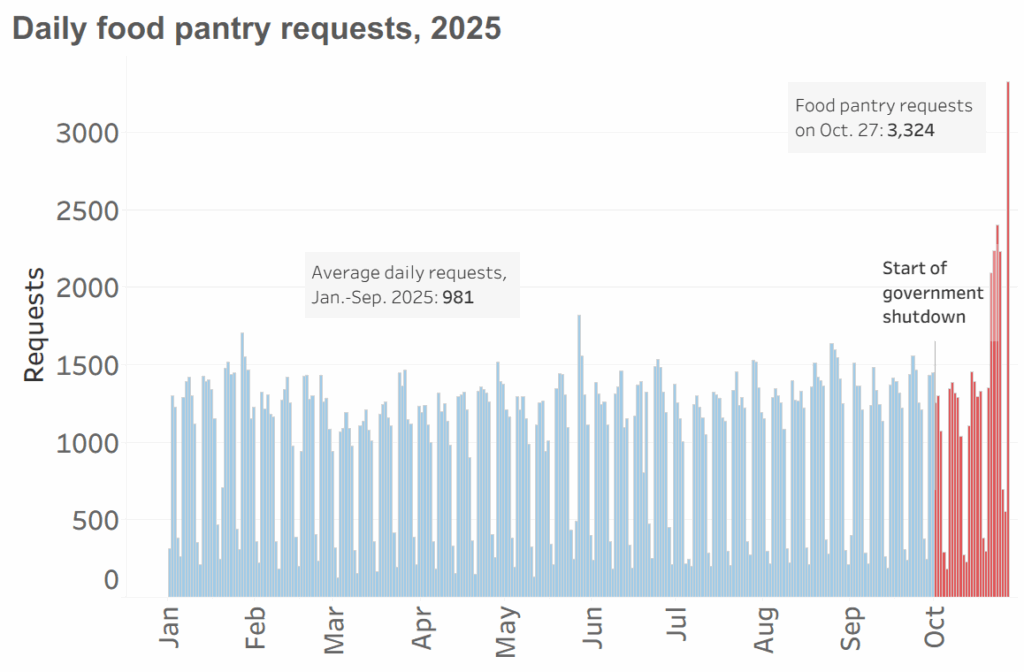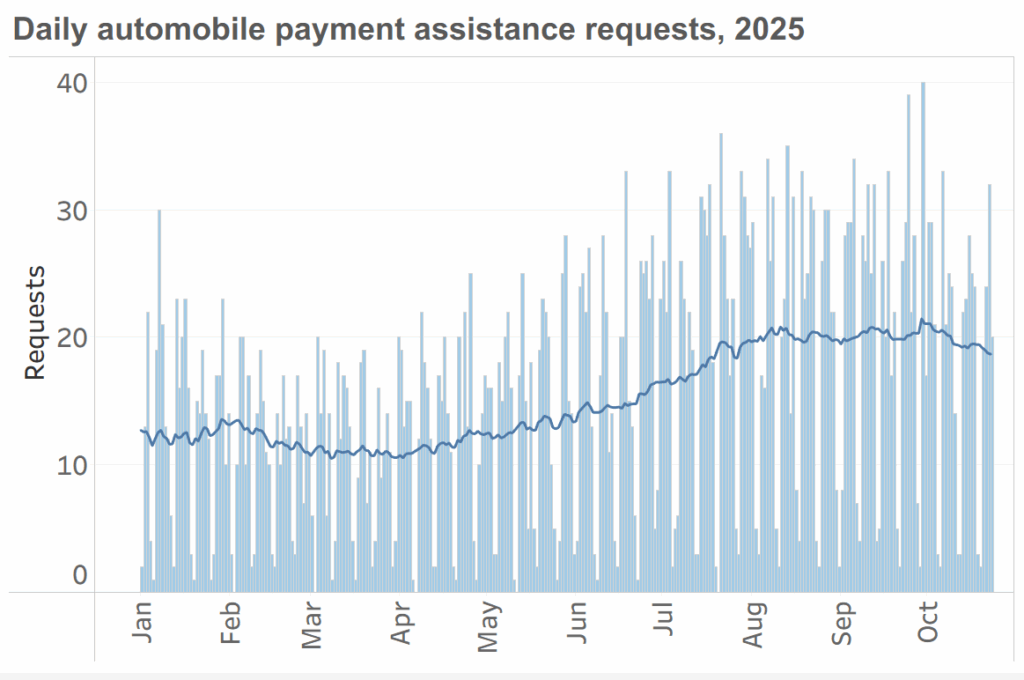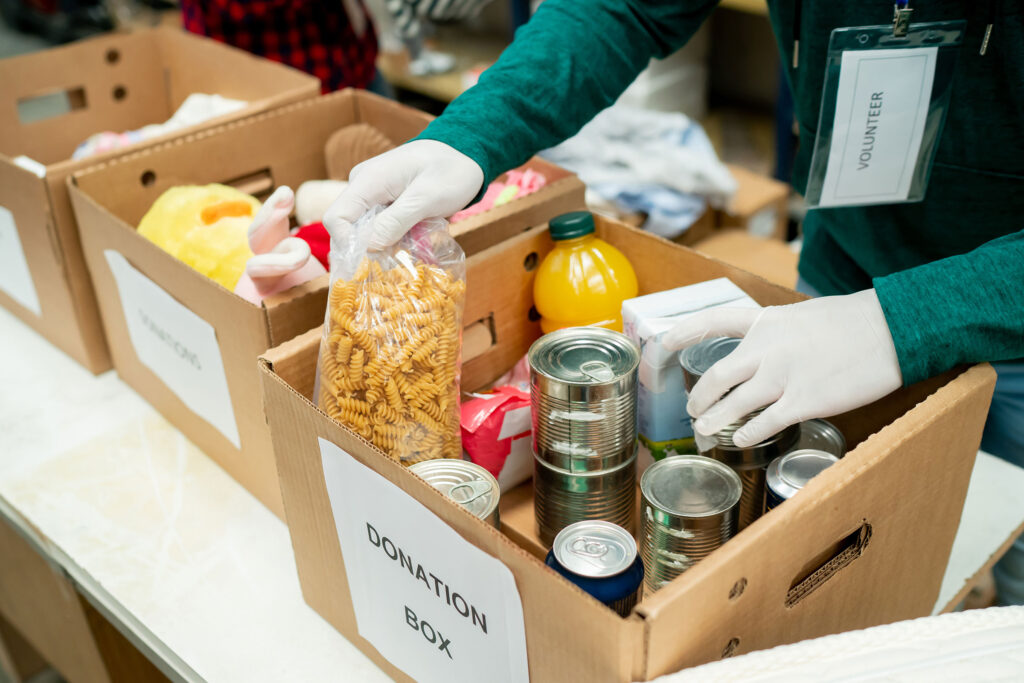Editor’s note: This story was updated on Tuesday, November 4, to include the Trump administration’s announcement of partial funding for SNAP benefits.
In the past week, phone calls for assistance finding food that were made to a national helpline have doubled and show no signs of coming back down, according to a data analysis by researchers at the School of Public Health at Washington University in St. Louis.
“Our best guess is that these are people who are fearful that their SNAP benefits will be stopped and are thinking ahead,” said Matthew Kreuter, PhD, the Kahn Family Professor of Public Health at WashU Public Health and one of the researchers who analyzed the data. “There has been talk for a while that benefits might be paused, but then Sunday (October 26), the Trump administration confirmed that the pause will happen, and on Monday we see this huge spike.”

Kreuter made those comments on Wednesday, October 29; at the time, the Monday data was the most recent data available. Since then, the numbers have only continued to rise. The average daily number of calls was 981 for January 1 through October 20, but on Monday, October 27, 211 call centers received 3,324 calls; on Tuesday, 3,870; on Wednesday, 4,214; and on Thursday, 3,854.
The data come from 211 Counts, a project of WashU Public Health’s Health Communication Research Laboratory, which Kreuter directs. 211 Counts compiles data on calls made to 211 — a national helpline that connects people seeking food, shelter, transportation, health care and other necessities, with local health and social service organizations. This analysis includes data from all or parts of 35 states.
The number of calls for referrals to food pantries already has matched or surpassed the peaks of the past two years, all of which occurred in the aftermath of natural disasters: Hurricane Beryl on the Gulf Coast, Hurricane Milton in Florida, and a deadly derecho in Texas.

SNAP benefits stopped being paid as of Saturday, November 1, but there are some signs that the benefits may be restored. On Friday, the day before the pause went into effect, two federal judges ordered the Trump administration to use emergency funds to pay for SNAP, and the following Monday, the Trump administration announced that it would authorize partial SNAP payments for the month of November. It is unclear when assistance will actually reach people.
“Many people rely heavily on their SNAP benefit, using food banks as a supplement, and know that pivoting to rely solely on food banks will not be enough,” said Tiffany Olson, the director of essential services at Crisis Connections, a social service organization in Washington state that operates a 211 call center. “Some callers have also reported fear of being able to access specialty foods — like allergy-safe or dietary-restriction foods — that they would normally buy with their SNAP benefits and are not as widely available at food pantries. People are also concerned about access to food banks during the shutdown, as they know that they will be more heavily burdened, and available food options may be less tenable with the significantly increased need.”
The 211 call data also revealed another worrisome trend: an increasing number of calls for assistance in making car payments. Unlike food aid requests, calls for help with car payments haven’t spiked recently; instead, they have been going up slowly but steadily since the spring and have now reached about double the baseline level of the past two years. This pattern suggests growing economic uncertainty nationwide. People may be looking for financial assistance with car payments so they can free up money for more critical necessities such as food and housing.
“If you can’t pay for everything, you’re going to stop paying on your car before you stop paying on your home,” Kreuter said. “We haven’t seen an increase in requests for help with home payments yet, but I worry that we will see that soon.”

211 Counts was established in 2014 to compile, organize and visualize data from the nationwide network of 211 centers. As a real-time snapshot of Americans’ needs, 211 Counts data can serve as an early-warning system for emerging problems. Months before the 2007 subprime mortgage crisis, the 2016 Flint water crisis and the 2022 baby formula shortage made news, signs of distress showed up in 211 Counts data.
See here for a previous story on 211 Counts: Rich trove of data on social needs waits to be tapped
